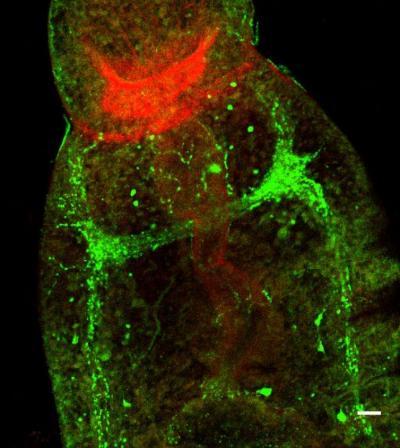Schistosoma mansoni and its close relatives are parasitic flatworms that affect millions worldwide and kill an estimated 250,000 people a year. A study published on January 16 in PLOS Pathogens identifies a new part of the molecular pathway that controls parasite movement. And because coordinated movement is essential for the schistosome life cycle in its human host, this protein is a promising new drug target.
"We know that many anti-parasitic drugs act on the worm's nervous system", says Paula Ribeiro from McGill University in Montreal, Canada, the lead author of the new study, "and have known for over 40 years that the neurotransmitter serotonin controls schistosome movement. As schistosomes are becoming resistant to the only effective drug we have, it was time to go after their serotonin receptor."
Serotonin is a signaling molecule that is used across species, including man, mouse, and worm. It exerts its function through specific serotonin receptors that span the membranes of nerve cells. When these receptors pick-up serotonin the nerve cells become activated. In some cases, this activation in turn activates muscle cells, eventually resulting in movement.
As nobody had discovered a schistosome serotonin receptor yet, Ribeiro and colleagues started by a computer (or "in silico") search for DNA sequences from S. mansoni that looked similar to known serotonin receptor genes. They found a candidate and verified that the corresponding protein, which they called Schistosoma mansoni 5HTR, or Sm5HTR, is indeed a serotonin receptor. When cells that have the protein embedded in their membrane get exposed to serotonin on the outside, the scientists could measure a typical response inside these cells.

This is the expression of a serotonin receptor (bright green) in the Schistosoma mansoni nervous system. The muscles of the oral sucker and the muscular lining of the digestive tract appear in red.
(Photo Credit: Nidhi Sharma, Institute of Parasitology, McGill University)
The scientists then went on to examine where in the parasite Sm5HTR is present, and report that the receptor is found widely on nerve cells in both larvae and adult worms. When they used various ways to interfere with receptor function, they found that larval and adult schistosomes were greatly inhibited in their movement. For example, when schistosome larvae are bathed in serotonin, they become twitchy and hyperactive. Larvae which have many fewer receptors don't show that response. And adult worms with fewer receptors move much less than those with normal numbers.
These studies suggest that even if schistosomes have additional serotonin receptors (and the in silico analysis suggests that there is at least one other), Sm5HTR is a major mediator of serotonin-controlled worm movement.
The authors conclude "We know from previous studies that locomotion is critical for survival of the parasite and that drug-induced paralysis is an effective way of clearing worm infections. Having identified Sm5HTR allows us to begin searching for selective receptor inhibitors that cause paralysis of the worm and may be suitable for therapeutic use."




Comments